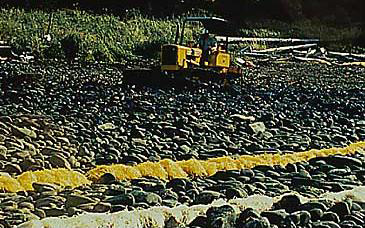Implications for Spill Response

After the Exxon Valdez spill, beaches were reworked by heavy machinery in order to move heavily-oiled upper intertidal sediments into the middle intertidal zone, where they could be washed by the surf and where the removed oil could be collected in booms. (NOAA)
Our intent in creating this monitoring program was to study shoreline ecological recovery after an environmental disaster like the Exxon Valdez spill, and then to use those lessons as scientific guidance for what we do in future response actions. Some of the findings have already changed the way we think about cleaning up oil spills.
Some examples of what we have learned that may be important for spill response include the following:
- Limiting the use of aggressive cleanup methods, such as hot-water washing, would help to temper the severe effects we have observed in biological communities.
- Using water to flush an oil-contaminated beach may also wash away fine-grained sediments and nutrients that small organisms need to successfully colonize, and it can take years for the fine sediment to return.
- Adult animals such as clams may survive in oil-contaminated beaches, but juveniles do less well and reproductive biology may be disrupted or impaired.
- Oil that penetrates deeply into beaches can remain relatively fresh for years and serve as a source of exposure to nearby animals.
- After large-scale excavation or reworking of gravel beaches, it can take years for the beach sediments and shoreline profile to recover.
- Gravel beaches should be of high priority for protection and cleanup because of the potential for deep penetration and slow weathering of oil.
Last updated
Wednesday, December 21, 2011 11:14am PST
